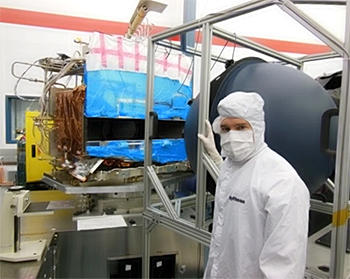Spectral irradiance and radiance responsivity calibrations using uniform sources (SIRCUS)
Summary
SIRCUS is a reference facility for the calibration of detectors and radiometers for spectral irradiance responsivity and spectral radiance responsivity across the UV, visible, and much of the infrared spectrum. SIRCUS uses continuously tunable lasers coupled into integrating spheres as a spectral irradiance or radiance source. The availability of lasers ultimately determines the spectral coverage available on SIRCUS while the ultimate uncertainties achievable are determined by the quality of the reference standard irradiance detectors. The high power and wavelength stability of the laser-based sources enable large aperture instruments, e.g. from remote sensing instruments to astronomical telescopes, and detector array-based imaging systems, to be characterized and calibrated.
Description

NASA scientist Joel McCorkel stands in front of the 1 m NIST integrating sphere with VIIRS in the background. NIST's traveling SIRCUS calibrated VIIRS for spectral responsivity and polarization dependence in Dec. 2014.
The SIRCUS facility is designed to reduce the uncertainty in irradiance and radiance responsivity calibrations to the 0.1 % level and to expand the spectral range where these uncertainty levels are achievable. The facility expands on previous work at NIST and the National Physical Laboratory (NPL) in the U.K. beginning in the mid-1980's using tunable lasers and silicon-based pyrometers traceable to cryogenic radiometers to determine the melting and freezing points of primary metal blackbodies with uncertainties approaching or exceeding those achievable using more conventional technologies.
All irradiance and radiance responsivity calibrations made in the SIRCUS facility are traceable to the U.S. standard for optical power, the Primary Optical Watt Radiometer (POWR), which is located in the SIRCUS facility. The optical power scale is transferred either directly from POWR, or a portable cryogenic radiometer that is directly traceable to POWR, to transfer detectors used in SIRCUS. The uncertainty in the detector responsivity is minimized by the short calibration chain from the primary cryogenic radiometer to the reference detector responsivity..The irradiance responsivity of the SIRCUS reference detector is derived from the power responsivity and the area of a precision aperture attached to the front of the detector. The area of this precision aperture is measured with uncertainties less than 100 ppm at the NIST Aperture Area Facility.
In many cases, instruments cannot travel to NIST for calibration. To increase the dissemination of the SIRCUS-based scale, we have developed Traveling SIRCUS. These table-top, tunable laser systems are portable and include integrating spheres and transfer standard detectors. The traveling SIRCUS units have been sent to NASA, NOAA, and USGS sites to characterize instruments in support of NIST's Environmental Remote Sensing Program.
For more information about the calibration setup and uncertainties for SIRCUS measurements, see SIRCUS facility and uncertainties.
Major Accomplishments
- SIRCUS has been used to support the realization of two fundamental Systeme Internationale (SI) units: the Kelvin above 1234.96 K (see Radiance temperature) and the the unit of luminous intensity, the candela (see Realization of the candela and the lumen).
- Recent improvements in the spectral radiant power responsivity measurements at the NIST Spectral Comparator Facility (SCF) are traced directly to improved calibrations of SCF transfer standards on SIRCUS (see Spectral responsivity measurements).
- SIRCUS characterization of the scattering properties of spectrographs and imaging systems have resulted in the development of correction algorithms to reduce the magnitude of errors arising from spectral and spatial stray light by one to two orders of magnitude.

